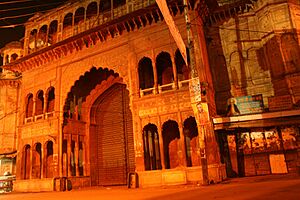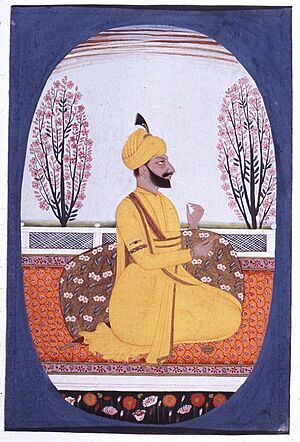Patiala state facts for kids
Patiala was a Sikh kingdom that existed from 1714 to 1948. Its rulers were from the Phulkian Dynasty. This family started with Chaudhary Phul (1627-1689), a leader from Mehraj village in the Bathinda District of Punjab. Other Sikh kingdoms, like Jind and Nabha, also came from the same Phul family. Patiala's capital was in the Malva region of Punjab. Its land stretched from Bathinda to what is now Mohali.
The Phul family belonged to the Sidhu clan. They lived in the Malva region of Punjab. Their family became Sikhs in the early 1600s. They believed they were related to Sidhu rulers from the 11th century. The family moved to the Malva region of Punjab. They settled near what is now the Bathinda District.
The Sidhu and Bhullar families in Bathinda often fought. But later, a leader named Nanu Bhullar arranged a marriage. His daughter married into the Sidhu family. This helped bring some peace between them.
The Phulkian Dynasty became well-known. Maharaja Ala Singh became friends with Ahmed Shah Abdali, an Afghan ruler. Other Sikh leaders did not like this friendship. In 1765, they met at Akal Takhat in Amritsar. They decided that Patiala should not be part of the main Sikh groups. That same year, Ala Singh died. His son, Amar Singh, became the next ruler. Ahmed Shah Abdali gave Maharaja Amar Singh the special title of Raja-i-Rajgan. He also allowed Amar Singh to make his own coins. Some Sikhs were not happy about this. Over time, the Phulkian rulers became allies with the British. They helped the British enter the Sikh areas of Punjab.
Sardar Hari Singh Dhillon (who ruled from 1746-1764) was a Sikh leader from Amritsar and Lahore. When he heard Ahmed Shah Abdali was in Patiala, he marched with his army. He wanted to chase Abdali away. But he was killed on the way. Years later, his younger son, Sardar Ganda Singh Dhillon (died 1776), arranged a marriage. His daughter, Bibi Rattan Kaur, married Maharaja Sahib Singh of Patiala in 1787. The wedding was in Amritsar. Five years later, Sahib Singh married Bibi As Kaur. Her sons and grandsons later became rulers.
From 1809 to 1947, the Patiala kingdom had good relations with the British. The royal family of Patiala was open to different ideas. They were very connected with the East India Company. At a time when many Sikh kingdoms did not want the British on their land, Patiala was one of the first to invite them. Later, after the kingdom ended, the royal family joined the Indian Congress party.
Art and Culture in Patiala
Patiala was different from other Sikh kingdoms in some ways. It showed respect for many religions. The later Maharajas of Patiala, like Karam Singh, brought Hindu paintings into their Qila Mubarak palace. These paintings of Hindu Gods can still be seen on the palace walls. This showed great respect for all faiths. Rajput Hindu paintings were very popular in Patiala from the 1800s. The Maharajas had themselves painted in the Rajput style. They also had connections with the Hindu royal families of Rajasthan.
Royal Family Connections
The Patiala rulers also had connections with Hindu Jat rulers. These were from the Royal Bharatpur State in Rajasthan. For example, in 1859, Maharaja Narinder Singh's third daughter, Maharani Bishan Kaur, married Rajah Jaswant Singh. He was the Jat ruler of Bharatpur State. Marriages between the Phulkian Jats and the royal Hindu Jats of Rajasthan were common in the 19th century.
Patiala's Rulers
Here is a list of the important rulers of Patiala:
- Maharaja Ala Singh (1691-1765)
- Maharaja Amar Singh (1748-1782)
- Maharaja Sahib Singh (1773-1813) - He was a weak ruler. He even imprisoned his own sister, Bibi Sahib Kaur, but she later escaped.
- Maharaja Karam Singh (1798-1845)
- Maharaja Narinder Singh (1823-1862)
- Maharaja Mahendra Singh (1852-1876)
- Maharaja Rajinder Singh (1872-1900)
- Maharaja Bhupinder Singh (1891-1938)
- Maharaja Yadavindra Singh (1913-1974)
- Captain Amarinder Singh (1942-1948)
Joining India
Maharaja Yadavindra Singh signed an agreement to join India in 1948. This meant his kingdom became part of the Government of India. Patiala State joined the Punjab State of India in 1948. The Maharaja also encouraged other royal kingdoms to join India.



